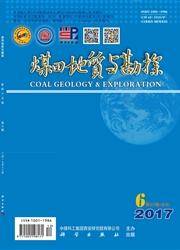

 中文摘要:
中文摘要:
断层面摩擦强度是评价煤炭开采中应力扰动诱发断层滑动危险性的依据。依托晋城矿区成庄井田,采用理论分析和数值模拟计算方法,分析了断层面摩擦强度对深部地应力的约束机制,研究了成庄井田F13断层及其在不同摩擦强度条件下对回采工作面顶板稳定性、超前支承压力分布和断层滑动的影响规律。研究结果表明:地壳深部最大与最小主应力比值受断层面摩擦强度的限制,当其达到临界方向断层的摩擦强度极限时,断层就会发生滑动;断层破碎带的存在导致初始应力场扰动,形成断层带低应力区及高应力集中区,在回采过程中将直接影响煤层顶板移动变形和采动应力分布;断层面摩擦强度较小时,工作面开采至断层附近顶板下沉量及断层上下盘错动位移较大,支承压力峰值由大变小明显,断层面上剪应力与正应力的比值易达到断层面的摩擦系数,断层滑动的危险性较大。
 英文摘要:
英文摘要:
Frictional strength of fault plane is the basis for estimating fault slip risk induced by stress disturbance during coal mining. Based on Chengzhuang coal mine field in Jincheng, constraint mechanism of frictional strength of fault plane to in-situ stress is analyzed, in addition, the effect law of F13 fault and its frictional strength on seam roof stability, lead abutment pressure and fault slip risk are also studied through both theoretical analysis and numerical simulation calculation. The results show that ratio of maximum to minimum principal stress in deep crust is constrained by frictional strength of fault plane, fault will slip when the ratio reaches the frictional strength extremum of fault plane located in critical direction. Fault fracture zone results in disturbance in initial stress field,forming low stress zone and high stress concentration zone around fault, which will have a immediate impact on movement, deformation and abutment pressure distribution of seam roof. Seam roof subsidence and alternate displacement of two fault walls are larger when frictional strength is smaller, it is obviously that lead abutment pressure decreases when working face advances near the fault. Ratio of the tangential stress to normal stress easily reaches frictional coefficient of fault plane, which will lead to higher fault slip risk.
 同期刊论文项目
同期刊论文项目
 同项目期刊论文
同项目期刊论文
 Coal strength and Young’s modulus related to coal rank,compressional velocity and maceral compositio
Coal strength and Young’s modulus related to coal rank,compressional velocity and maceral compositio Experimental research on the permeability of high-rank coal under a varying stress and its influenci
Experimental research on the permeability of high-rank coal under a varying stress and its influenci 期刊信息
期刊信息
